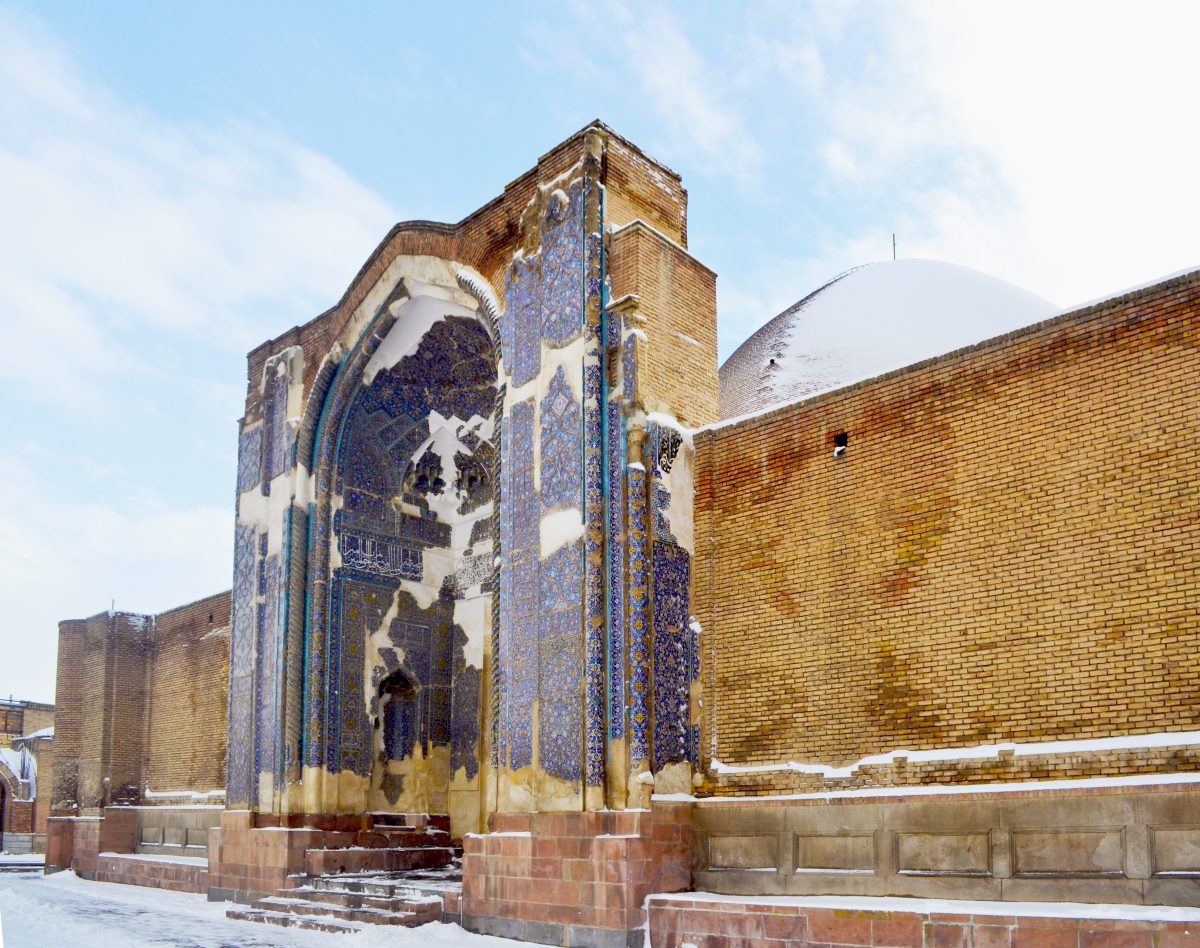Table of Contents
After the arrival of Islam in Iran, the people of Iran accepted this religion well and integrated it with their authentic beliefs and culture. One of the results of this integration was the emergence of Iranian-Islamic art and culture. Iran’s historic, magnificent mosques are a clear example of Iranian-Islamic art. One of these beautiful mosques is Blue Mosque Tabriz.
This extraordinary place of worship, distinguished by its rich blue tiles, has earned its moniker due to the stunning azure adornments that grace its structure. Nestled in the heart of Tabriz city, the Blue Mosque stands as a beacon of artistic and historical importance, beckoning travelers from far and wide. In this article, we briefly explore the significance of the Blue Mosque Iran. Additionally, we provide the necessary information for visiting.
Iran Blue Mosque History
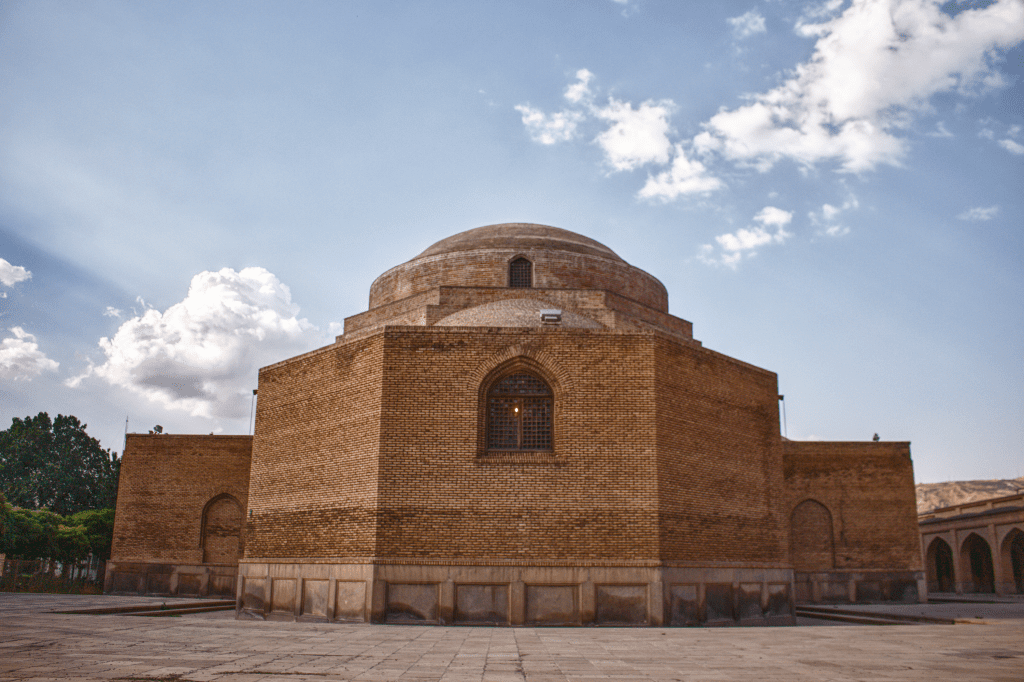
The Blue Mosque, known locally as “Masjed-e Kabud” in Persian and “Goy Masjed” in Azeri, both translating to “Blue Mosque” in English, is a testament to the grandeur of 15th-century architecture. Commissioned in 1465 by Shah Jahan, a prominent ruler of the Qara Qoyunlu dynasty, this mosque once held a place of unparalleled fame in its era. Based on an inscription on the mosque’s portal, the construction ended in 1465. Today, it remains the sole surviving relic from the Qaraquyunlus era, a testament to its remarkable and unique architecture.
Why Does the Blue Mosque in Iran Matter?
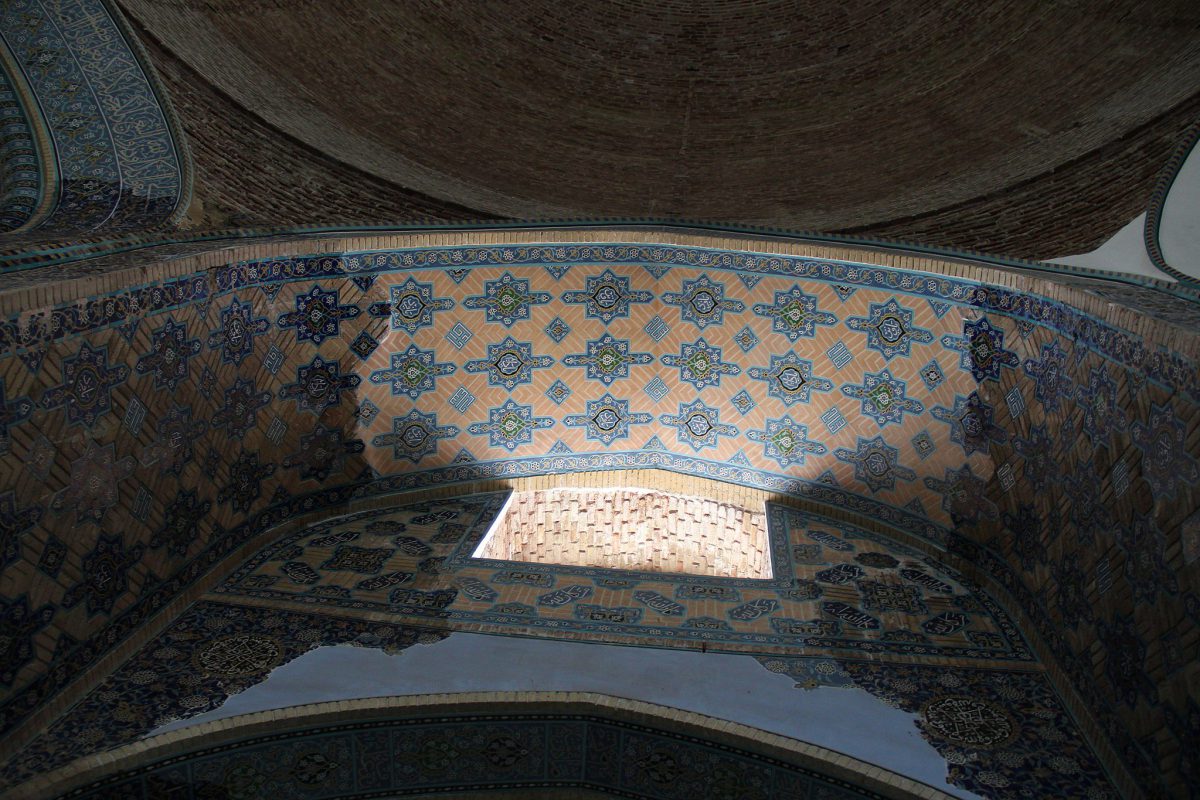
The Blue Mosque of Tabriz holds a special place in history enthusiasts’ and art lovers’ hearts. Often referred to as the “Turquoise of the Islamic World,” its significance extends beyond its breathtaking aesthetics. The mosque’s distinctive features, including intricate tiling, calligraphy, and geometric patterns, offer a glimpse into the architectural brilliance of the 15th century. Moreover, its historical importance as a relic from the Qara Qoyunlu dynasty adds to its allure.
The Blue Mosque Iran Architecture
What sets the Blue Mosque apart from its counterparts is its exceptional architectural design, which remains unmatched in the realm of Iranian mosques. A fusion of Persian and Ottoman influences, this masterpiece was crafted during a time when the Qara Qoyunlu dynasty, with Turkish roots, reigned over parts of Iran, Iraq, Azerbaijan, Georgia, Armenia, and eastern Turkey. The architect’s decision to incorporate Ottoman design elements resulted in a stunning and unique blend of Islamic architectural styles.
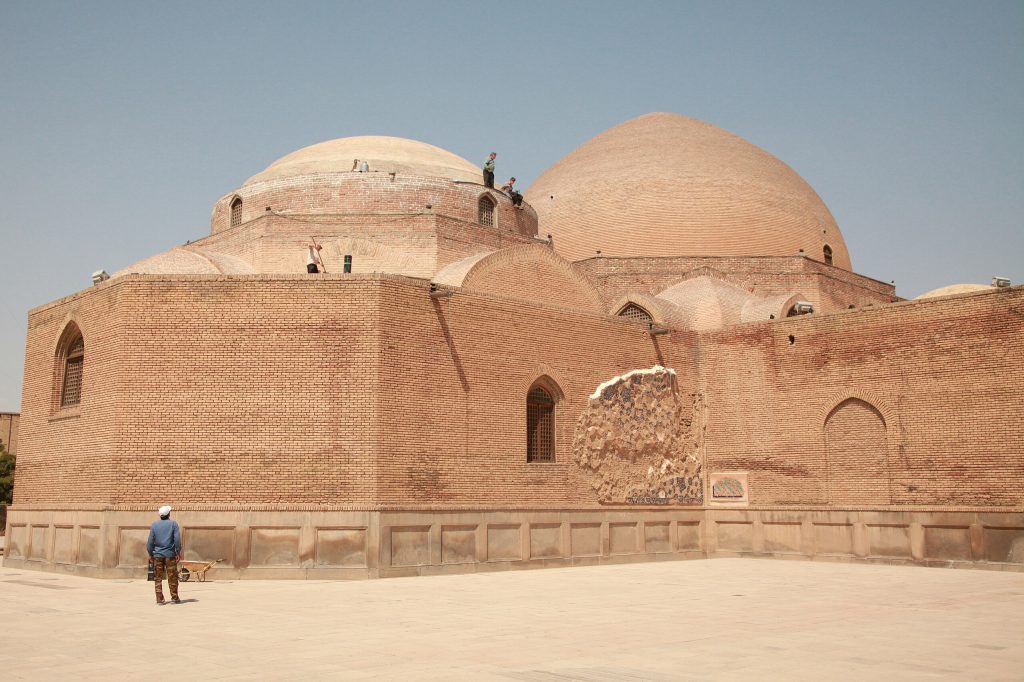
Historically, Iran Blue Mosque was part of a grand complex known as the “Muzafaria Building,” a name preserved in various historical sources. Within the sprawling Mozaffaria mansion, constructed in the Azari architectural style, stood not only the Blue Mosque but also a monastery, a courtyard, a library, and tombs.
The Blue Mosque can be likened to the Goharshad Mosque in Mashhad City in architectural splendor and ornate decorations. Both these architectural wonders belong to the same epoch, showcasing the magnificence of their era.
The construction of the Blue Mosque, in particular, is a testament to the meticulous attention paid to the region’s climate, rendering it harmoniously adapted to Tabriz’s seasonal variations. The mosque’s courtyard, thoughtfully designed, proves inviting in every season.
The dome of the mosque is located in the middle of the courtyard, and the intelligent architecture of the mosque has made it possible to use the courtyard at any time of the year due to the cold climate of Tabriz City. Small closets were installed at the bottom of the columns to store shoes. The pond in the middle of the courtyard was also placed for the worshipers to perform ablution.
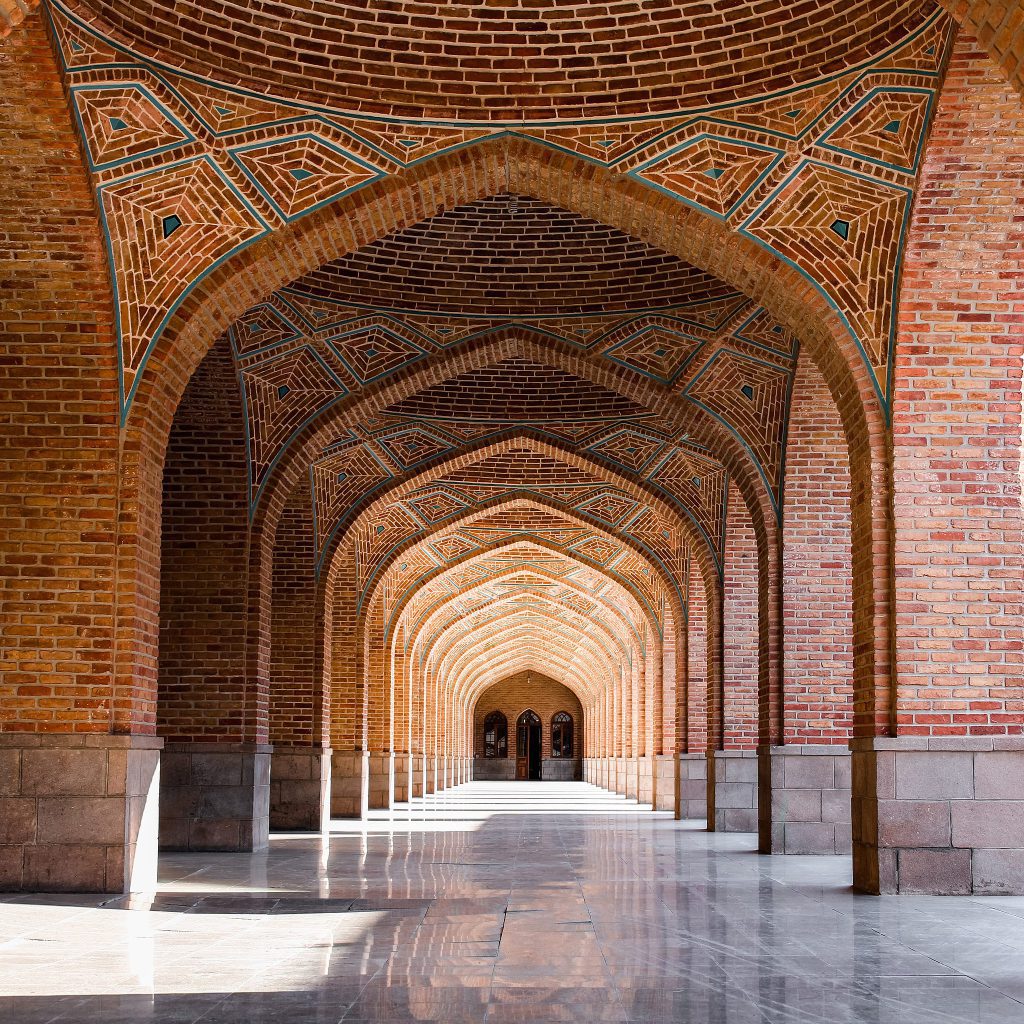
Ablution is a cleansing ritual for religious or spiritual practices. It involves washing specific body parts, like hands and face, to prepare for prayer or worship. It’s found in various religions, with different techniques and meanings.
The construction predominantly relies on bricks, while occasional accents of marble elevate its aesthetics. These bricks are meticulously bound together with plaster, contributing to the building’s robust structure. The main edifice assumes a square and symmetrical form, exuding timeless elegance. An enchanting pond graces the heart of the square courtyard, flanked on either side by charming chapels. A masterful blend of brickwork and mosaic tiles adorns the surfaces throughout the building, accentuating its aesthetic richness with intricate patterns and designs.
Within the confines of the Blue Mosque, you encounter a smaller dome, originally featuring a marble door from the inside, although the door has been lost. This smaller dome was constructed to house the tombs at the mosque’s far end.
Despite the ravages of time, invaluable insights into the architecture and location of the building’s construction have been gleaned from historical records. Notably, paintings by Matraqchi dating to approximately 940-942 AH (1533-1536 AD) and French Chardin’s designs from around 1084 AH (1673 AD) have provided essential information for understanding the structure’s history.
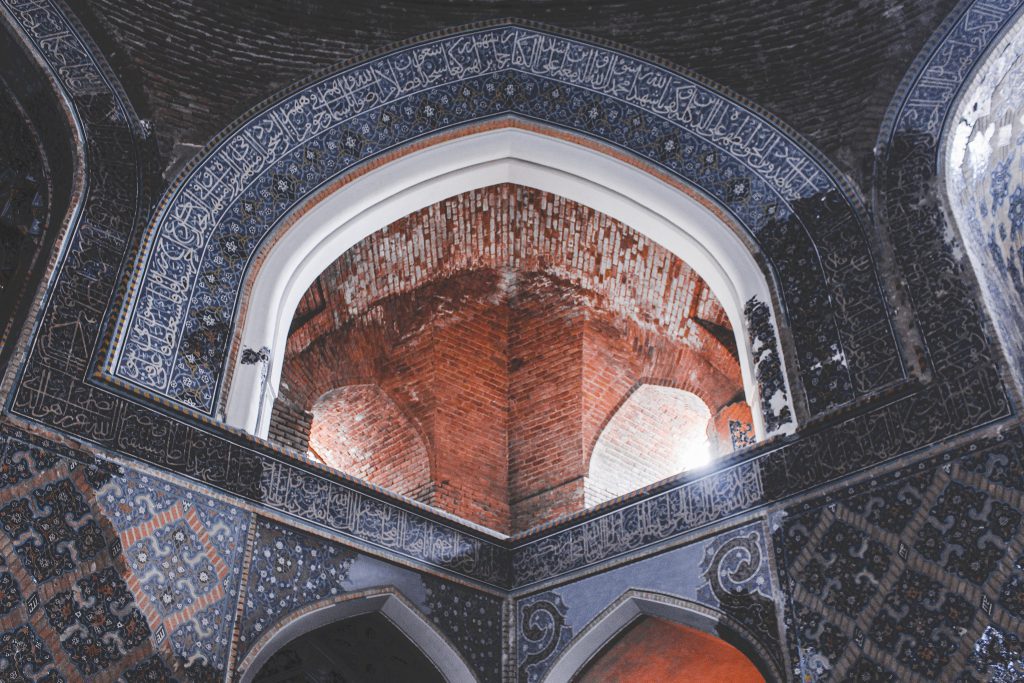
Today, significant efforts have gone into restoring the primary elements of the mosque, allowing visitors to step inside and relive the grandeur of the Blue Mosque. The entrance gate is a testament to exquisite design, earning admiration from architects worldwide. Azure tiles, many of them hexagonal, adorn various sections of the mosque, enhancing its allure. The architectural magnificence of the Blue Mosque continues to captivate tourists and architects, both local and international, drawn by its timeless charm and historical significance.
The Destruction of the Blue Mosque Tabriz
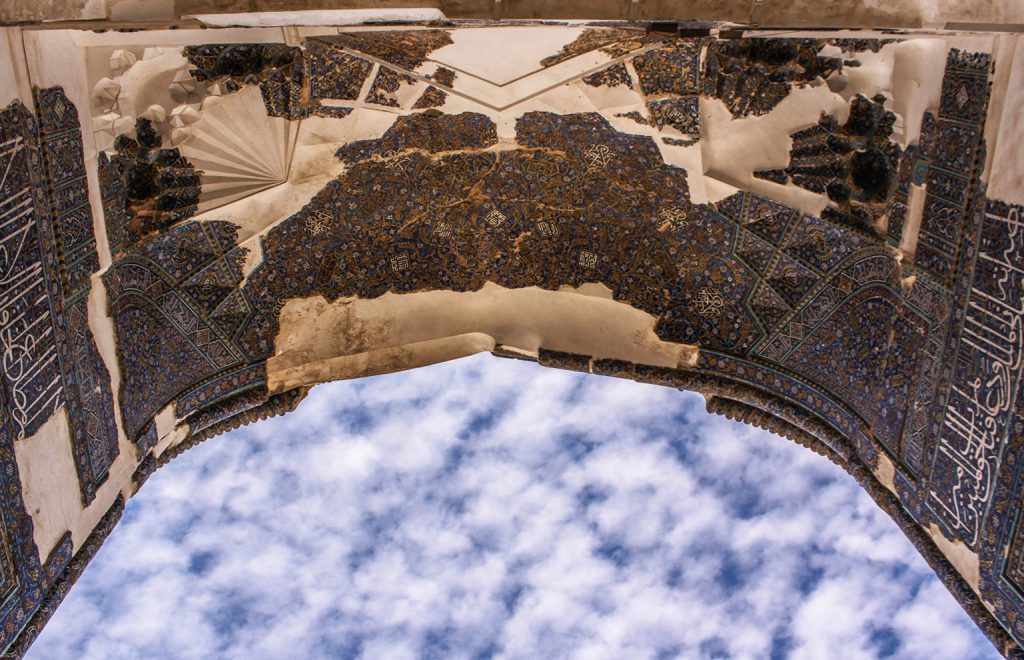
Standing before the magnificent entrance of the Blue Mosque, one cannot help but notice the conspicuous gaps in its once-blanket of blue tiles. These gaps, a testament to the mosque’s tumultuous history, were inflicted by two devastating earthquakes, one in 1727 and another in 1773. Despite ongoing efforts to restore its former glory since 1973, the reconstruction remains unfinished, leaving only a portal and scattered pillars as witnesses to the mosque’s former grandeur.
Before the earthquakes, the Blue Mosque was part of a sprawling architectural complex that included a mosque, a monastery, a courtyard, and a library. Tragically, these structures fell victim to the destructive forces of nature, leaving only remnants of the main gate, dome, and outer walls behind. The inscription on the mosque’s portal dates its construction to the 15th century, during the reign of Abu Mozaffar Jahanshah Gharaghuiunlu. In 1940, efforts to preserve the remaining vestiges commenced and concluded in 1975 under the skilled hands of Reza Memaran. Restoration work on the interior and exterior tiling continues to this day.
How to Get to Blue Mosque Tabriz
Address: Imam Street, nestled between Saat Square and Mansour Intersection.
This historical gem is a prominent landmark in Tabriz, Iran, and can be easily accessed by various modes of transportation. Whether you choose to take a leisurely stroll through the charming streets of Tabriz, hop on public transport, or opt for a taxi, the Blue Mosque’s central location makes it convenient for visitors to explore its stunning architecture and immerse themselves in the rich history and culture of this beautiful city. Don’t miss the opportunity to marvel at the intricate design and vibrant blue tiles that adorn this architectural masterpiece when you make your way to the Blue Mosque.
If you’re not already familiar with Iran’s private transportation platforms, I strongly recommend taking a moment to read this informative article:
Best Time to Visit Iran Blue Mosque
The best time to visit the Iran Blue Mosque is during the spring and autumn months, typically from April to June and September to November. During these periods, the weather in Tabriz is pleasantly mild, with comfortable temperatures that make exploring the mosque and its surroundings a delightful experience. Spring brings lush greenery and colorful blooms to the city, adding to the mosque’s picturesque setting. Additionally, autumn offers crisp, clear days that are ideal for outdoor excursions. While summer can be quite hot, and winter can be cold and snowy in Tabriz, the shoulder seasons provide the most favorable conditions for enjoying the beauty and historical significance of the Iran Blue Mosque.
Iran Blue Mosque Ticket And Opening Hours
If you plan to visit the Blue Mosque, just a heads up that the entrance fee is 1,000,000 Rials, which is about $2 in 2023.
The good news is that it’s open every day from 8 a.m. to 5 p.m., so you can stop by whenever it fits your schedule.
Best Restaurants Near Blue Mosque Tabriz
- Shazdeh Traditional Restaurant: They offer a variety of kebabs as well as Persian and Azari cuisine.
- Ham Traditional Restaurant: offers a diverse menu of Persian dishes, including kebabs, stews, Ash, and soups
- Talkhoun Traditional Restaurant: Visitors can indulge in authentic Persian dishes and succulent kebabs. Additionally, guests can browse through their collection of exquisite carpets at the on-site shop.
Best Hotels Near Blue Mosque Tabriz
- Sorkheyi Boutique Hotel: The Sorkhei Mansion of Tabriz or Mirza Mahdi Farashbashi Mansion Boutique Hotel is situated in the city’s ancient and historic Sorkhab neighborhood. This mansion was previously owned by the Farash Bashi family, who were related to Mozafaruddin Shah Qajar. The location of this hotel is advantageous as it provides convenient access to shopping centers and cultural and historical landmarks, such as the Qajar Museum, the Tomb of Poets, and other attractions in the enchanting city of Tabriz.
- Behboud Apartment Hotel: As a guest, you will feel right at home thanks to the welcoming environment. Each suite in this hotel is a spacious two-bedroom apartment with four comfortable beds. Families of two or three people and solo travelers can take advantage of the special pricing to enjoy the comfort of a large suite at the prices of one, two, or three people. Children under three years stay free, while children between three and seven years old are charged half price.
- Tabriz Azadi Hotel: The Azadi Tabriz Hotel is a four-star establishment at the renowned Shariati crossroads. Recently built, the hotel has four floors and offers 43 rooms and suites with modern amenities. This complex boasts several advantages, including its proximity to the Azerbaijan Museums, Constitutional Museum, Blue Mosque, Tabriz Grand Bazaar, Saat Square, and BRT bus routes for easy access to the eastern and western parts of the city. It also provides convenient access to the Kandavan village.
- Esteghbal Hotel: Tabriz Esteghbal Hotel is situated in the Sorkhab neighborhood, which has a rich historical background and is known for its nobility. The hotel is centrally located in Tabriz and offers a stunning view of the Tomb of Poets. It is conveniently close to Amir Nezam’s House, the Pottery Museum, Tabriz Grand, and the Historical Market.
- Caspian Hotel: The Caspian Tabriz Hotel is a 3-star hotel with 20 rooms near the Blue Mosque. It consists of 4 floors above ground and two below ground.
Attractions Near Blue Mosque Tabriz
Azerbaijan Museum
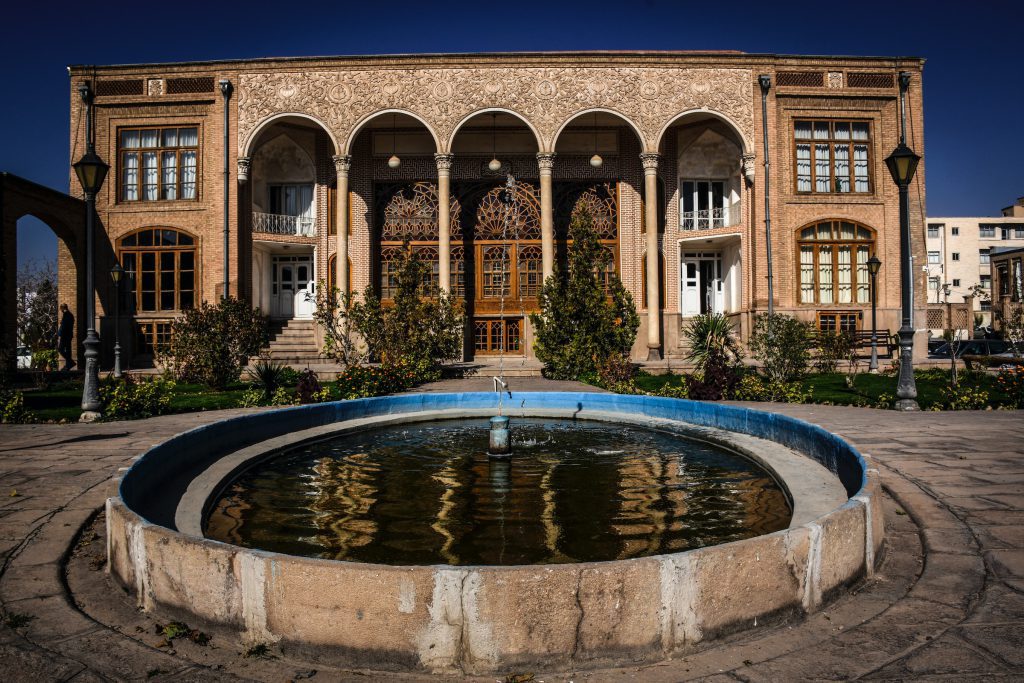
The Azerbaijan Museum is a treasure trove of history and culture. Here, you’ll find artifacts and exhibitions showcasing the region’s rich heritage, spanning from ancient times to the modern era.
Tabriz Firefighting Tower
The Tabriz Firefighting Tower is a unique architectural marvel. This historic tower once served as a lookout point for spotting fires in the city and has now been transformed into a museum, offering visitors a glimpse into Tabriz’s firefighting history.
Tabriz Grand Bazaar
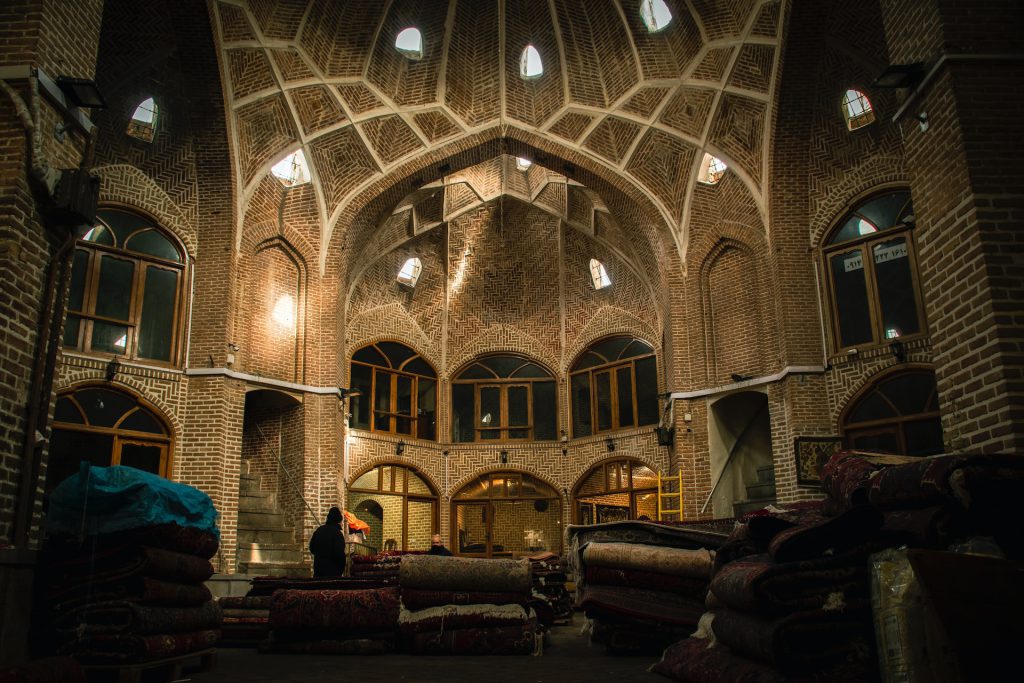
Prepare to immerse yourself in a bustling maze of shops, stalls, and alleys at the Tabriz Grand Bazaar. It’s one of the world’s oldest and largest covered markets, where you can shop for traditional Persian rugs, spices, textiles, and much more.
Jameh Mosque of Tabriz
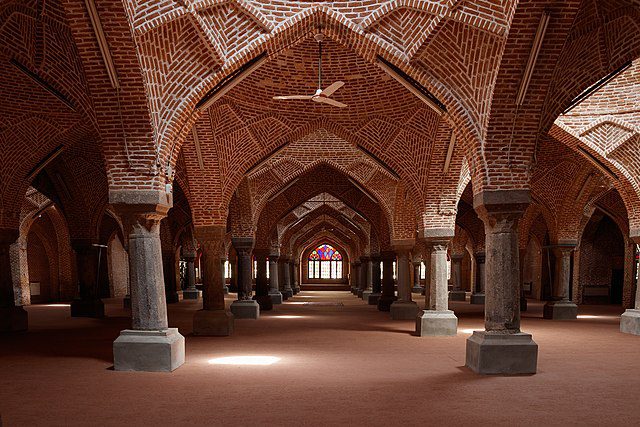
The Jameh Mosque is a magnificent example of Islamic architecture. Its stunning blue-tiled façade and intricate design make it a must-visit for anyone interested in history, religion, or architecture.
Municipality Palace of Tabriz
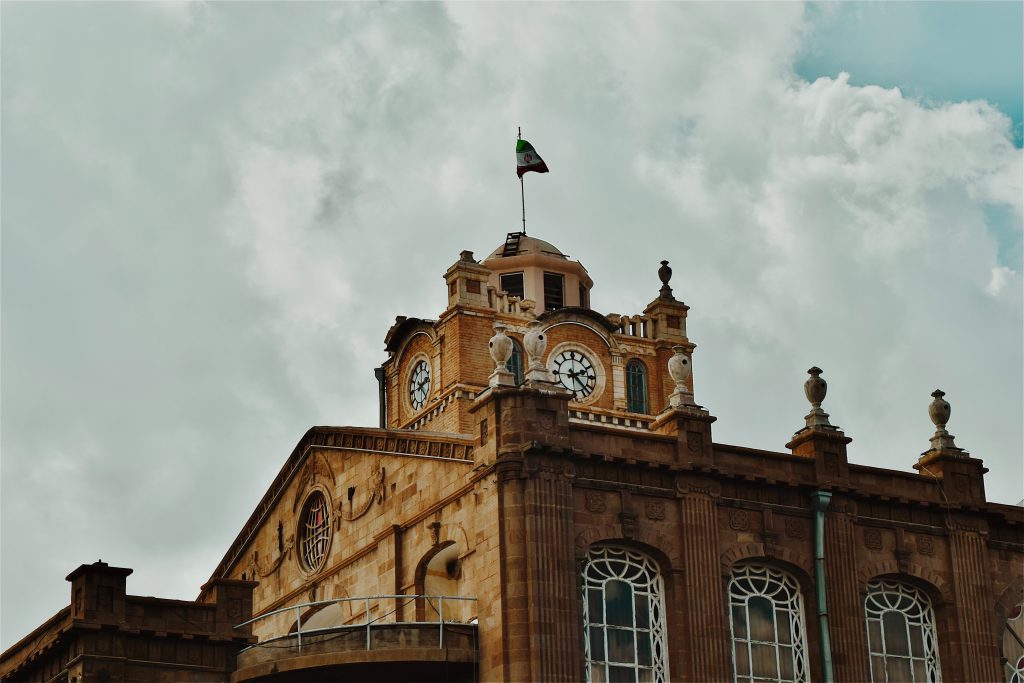
The Municipality Palace is a striking building that showcases a blend of Persian and European architectural styles. It’s an iconic symbol of Tabriz and offers a glimpse into the city’s modern governance.
Heidarzadeh’s House
Step back in time as you explore Heidarzadeh’s House, a beautifully preserved traditional Iranian residence. It’s a fascinating insight into the lifestyle and architecture of affluent families in the past.
Behnam House
Behnam House is another historic gem in Tabriz. This traditional Iranian house is renowned for its intricate plasterwork, stained glass windows, and tranquil courtyards, providing a serene escape from the city’s hustle and bustle.
Shahriar’s House Museum
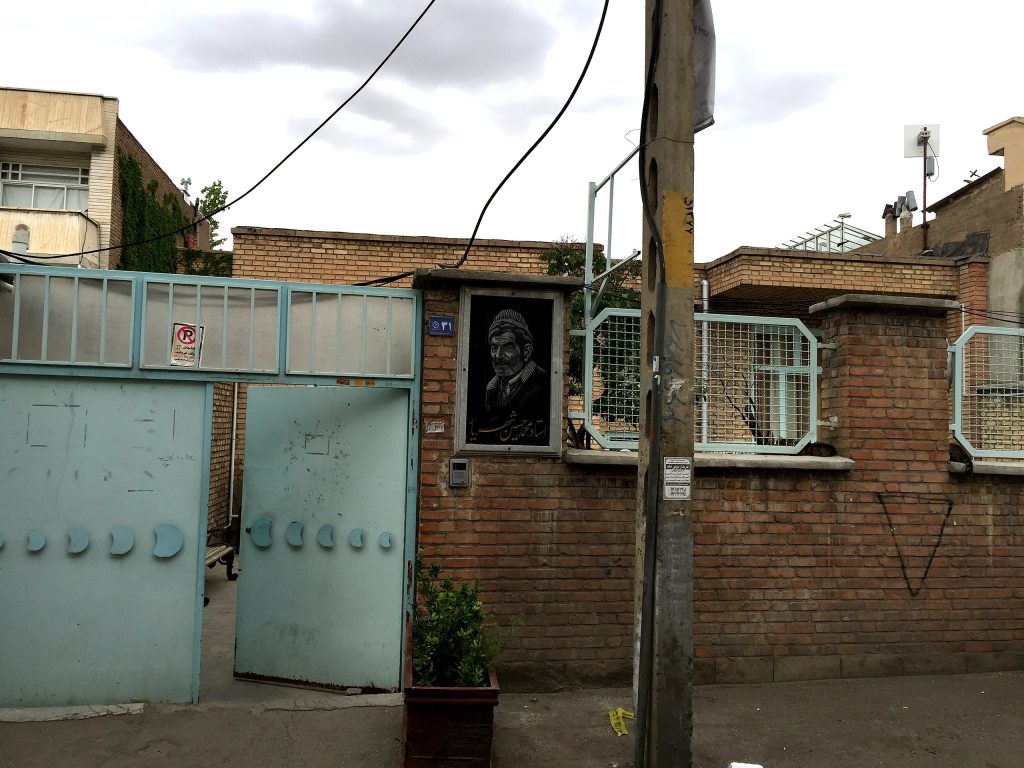
Shahriar’s House Museum is dedicated to the famous Iranian poet Shahriar. Visitors can explore the life and works of this literary giant while admiring the architecture and design of the house itself.
Tabriz, with its rich history and cultural heritage, offers a diverse range of attractions that cater to the interests of history buffs, architecture enthusiasts, and those seeking to immerse themselves in the vibrant local culture. Enjoy your visit!
FAQs about the Blue Mosque Tabriz
Q1: Was the Blue Mosque affected by an earthquake?
A1: Yes, the Blue Mosque in Tabriz, Iran, has been affected by several earthquakes throughout its history. The mosque has faced various degrees of damage due to seismic activity in the region.
Q2: When was Iran Blue Mosque destroyed?
A2: The Blue Mosque in Tabriz, Iran, was severely damaged by an earthquake in 1779. However, it was not wholly destroyed and underwent subsequent renovations and restoration efforts.
Q3: Why is the Blue Mosque called the Blue Mosque?
A3: The Blue Mosque is named after its stunning blue-tiled decoration. The intricate blue tilework is a prominent feature of the mosque’s design, which gives it its distinctive name.
Q4: Is the Blue Mosque Tabriz still used?
A4: The Tabriz Blue Mosque has become a popular tourist destination due to its magnificent architecture.
Q5: Why is the Blue Mosque not blue?
A5: While the Blue Mosque is commonly referred to as such due to its blue-tiled interior, the exterior of the mosque may not appear entirely blue except for the entrance. The blue tiles are predominantly found inside, decorating the walls and ceilings, which is why the interior is famous for its blue coloration.
Q6: Is the Blue Mosque Tabriz safe?
A6: Yes, Thanks to the recent reconstructions, Iran Blue Mosque is now a secure destination to explore. For those passionate about photography, it is a must-see dream destination that offers incredible opportunities to capture breathtaking moments.
Q7: Do you have to wear hijab in the Blue Mosque Iran?
A7: Yes, Visitors to Iran, including the Blue Mosque Tabriz, should follow Iran’s dress code, such as wearing a hijab for women and dressing conservatively.
Q8: Is Blue Mosque Tabriz free to visit?
A8: The entrance fee for Blue Mosque Tabriz is 1,000,000 Rials, approximately $2 in 2023.
Q9: How old is Blue Mosque Tabriz?
A9: The Blue Mosque in Tabriz, Iran, dates back to the 15th century. It was constructed during the reign of Kara Koyunlu ruler Jahan Shah in the late 1400s, making it over 500 years old and a remarkable testament to Persian architecture and history.
To Iran Tour
Despite its tumultuous history and ongoing restoration, the Blue Mosque in Iran is a testament to a bygone era’s artistic prowess. A dreamy destination for photography enthusiasts and a must-see for travelers to Tabriz, this architectural marvel continues to enchant with its exquisite turquoise and azure mosaic tiles, Islamic motifs, and intricate geometric designs. Its enduring beauty and historical significance make it a jewel in Iran’s architectural crown.
Embark on a delightful journey to explore the enchanting city of Tabriz and the awe-inspiring Blue Mosque in Iran with To Iran Tour’s carefully crafted travel packages. Our offerings span a diverse range of tours, from immersive one-day adventures to extended explorations, all thoughtfully guided by our knowledgeable local experts. Join us in uncovering the beauty and history of this remarkable destination.

